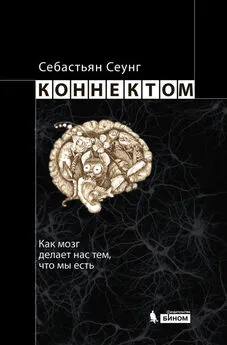Себастьян Сеунг - Коннектом. Как мозг делает нас тем, что мы есть
- Название:Коннектом. Как мозг делает нас тем, что мы есть
- Автор:
- Жанр:
- Издательство:Литагент «БИНОМ. Лаборатория знаний»a493f192-47a0-11e3-b656-0025905a06ea
- Год:2014
- Город:Москва
- ISBN:978-5-9963-2672-3
- Рейтинг:
- Избранное:Добавить в избранное
-
Отзывы:
-
Ваша оценка:
Себастьян Сеунг - Коннектом. Как мозг делает нас тем, что мы есть краткое содержание
Что такое человек? Какую роль в формировании личности играют гены, а какую – процессы, происходящие в нашем мозге? Сегодня ученые считают, что личность и интеллект определяются коннектомом, совокупностью связей между нейронами. Описание коннектома человека – невероятно сложная задача, ее решение станет не менее важным этапом в развитии науки, чем расшифровка генома, недаром в 2009 году Национальный институт здоровья США запустил специальный проект – «Коннектом человека», в котором сегодня участвуют уже ученые многих стран.
В своей книге Себастьян Сеунг, известный американский ученый, профессор компьютерной нейробиологии Массачусетского технологического института, рассказывает о самых последних результатах, полученных на пути изучения коннектома человека, и о том, зачем нам это все нужно.
Коннектом. Как мозг делает нас тем, что мы есть - читать онлайн бесплатно ознакомительный отрывок
Интервал:
Закладка:
155. Huttenlocher, P. R., C. de Courten, L. J. Garey, and H. Van der Loos. 1982. Synaptogenesis in human visual cortex-evidence for synapse elimination during normal development. Neuroscience Letters , 33 (3): 247–252.
156. Illingworth, C. M. 1974. Trapped fingers and amputated finger tips in children. Journal of Pediatric Surgery , 9 (6): 853–858.
157. Jain, V., H. S. Seung, and S. C. Turaga. 2010. Machines that learn to segment images: A crucial technology for connectomics. Current Opinion in Neurobiology , 20 (5): 653–666.
158. Jarvis, E. D., O. Güntürkün, L. Bruce, A. Csillag, H. Karten, W. Kuenzel, L. Medina, G. Paxinos, D. J. Perkel, T. Shimizu, et al. 2005. Avian brains and a new understanding of vertebrate brain evolution. Nature Reviews Neuroscience , 6 (2): 151–159.
159. Johansen-Berg, H., and M. F. S. Rushworth. 2009. Using diffusion imaging to study human connectional anatomy. Annual Review of Neuroscience , 32: 75–94.
160. Johnson, L., and S. Baldyga. 2009. Frozen: My journey into the world of cryonics, deception, and death. New York: Vanguard.
161. Jones, P. E. 1995. Contradictions and unanswered questions in the Genie case: A fresh look at the linguistic evidence. Language and Communication , 15 (3): 261–280.
162. Jun, J. K., and D. Z. Jin. 2007. Development of neural circuitry for precise temporal sequences through spontaneous activity, axon remodeling, and synaptic plasticity. PLoS One , 2 (8): e273.
163. Jung, R. E., and R. J. Haier. 2007. The parieto-frontal integration theory (P-FIT) of intelligence: Converging neuroimaging evidence. Behavioral and Brain Sciences , 30 (2): 135–154.
164. Kahn, D. 1967. The codebreakers: The story of secret writing. New York: Macmillan.
165. Kaiser, M. D., C. M. Hudac, S. Shultz, S. M. Lee, C. Cheung, A. M. Berken, B. Deen, N. B. Pitskel, D. R. Sugrue, A. C. Voos, et al. 2010. Neural signatures of autism. Proceedings of the National Academy of Sciences , 107 (49): 21223–21228.
166. Kalil, R. E., and G. E. Schneider. 1975. Abnormal synaptic connections of the optic tract in the thalamus after midbrain lesions in newborn hamsters. Brain Research , 100 (3): 690.
167. Kalimo, H., J. H. Garcia, Y. Kamijyo, J. Tanaka, and B. F. Trump. 1977. The ultra-structure of “brain death.” II. Electron microscopy of feline cortex after complete ischemia. Virchows Archiv B Cell Pathology , 25 (1): 207–220.
168. Kanner, L. 1943. Autistic disturbances of affective contact. Nervous Child , 2 (2): 217–230.
169. Karten, H. J. 1997. Evolutionary developmental biology meets the brain: The origins of mammalian cortex. Proceedings of the National Academy of Sciences , 94 (7): 2800–2804.
170. Keith, A. 1927. The brain of Anatole France. British Medical Journal , 2 (3491): 1048.
171. Keller, M. B., J. P. McCullough, D. N. Klein, B. Arnow, D. L. Dunn er, A. J. Gelenberg, J. C. Markowitz, C. B. Nemer off, J. M. Russell, M. E. Thase, et al. 2000. A comparison of nefazodone, the cognitive behavioral-analysis system of psyc hotherapy, and their combination for the treatment of chronic depression. New England Journal of Medicine , 342 (20): 1462–1470.
172. Keller, S. S., T. Crow, A. Foundas, K. Amunts, and N. Roberts. 2009. Broca’s area: Nomenclature, anatomy, typology, and asymmetry. Brain and Language , 109 (1): 29–48.
173. Kelly, Kevin. 1994. Out of control: The rise of neo-biological civilization . Reading, Mass.: Addison-Wesley.
174. Kempermann, G. 2002. Why new neurons? Possible functions for adult hippocampal neurogenesis. Journal of Neuroscience , 22 (3): 635.
175. Kessler, R. C., O. Demler, R. G. Frank, M. Olfson, H. A. Pincus, E. E. Walters, P. Wang, K. B. Wells, and A. M. Zaslavsky. 2005. Prevalence and treatment of mental disorders, 1990 to 2003. New England Journal of Medicine , 352 (24): 2515.
176. Kim, I. J., Y. Zhang, M. Yamagata, M. Meister, and J. R. Sanes. 2008. Molecular identification of a retinal cell type that res ponds to upward motion. Nature , 452 (7186): 478–482.
177. Knott, G., H. Marchman, D. Wall, and B. Lich. 2008. Serial section scanning electron microscopy of adult brain tissue using focu sed ion beam milling. Journal of Neuroscience , 28 (12): 2959.
178. Knudsen, E. I., and P. F. Knudsen. 1990. Sensitive and critical periods for visual calibration of sound localization by barn owls. Journal of Neuroscience , 10 (1): 222.
179. Kola, I., and J. Landis. 2004. Can the pharmaceutical industry reduce attrition rates? Nature Reviews Drug Discovery , 3 (8): 711–716.
180. Kolb, B., and R. Gibb. 2007. Brain plasticity and recovery from early cortical injury. Developmental Psychobiology , 49 (2): 107–118.
181. Kolodkin, A. L., and M. Tessier-Lavigne. 2011. Mechanisms and molecules of neuronal wiring: A primer. Cold Spring Har bor Perspectives in Biology , 3: a001727.
182. Kolodzey, J. 1981. Cray-computer technology. IEEE Transactions on Components, Hybrids, and Manufacturing Technology , 4 (2): 181–186.
183. Kornack, D. R., and P. Rakic. 1999. Continuation of neurogenesis in the hippocampus of the adult macaque monkey. Procee dings of the National Academy of Science s, 96 (10): 5768.
184. Kornack, D. R., and P. Rakic. 2001. Cell proliferation without neurogenesis in adult primate neocortex. Science , 294 (5549): 2127.
185. Kostovic, I., and P. Rakic. 1980. Cytology and time of origin of interstitial neurons in the white matter in infant and adult human and monkey telencephalon. Journal of Neurocytology, 9 (2): 219.
186. Kozel, F. A., K. A. Johnson, Q. Mu, E. L. Grenesko, S. J. Laken, and M. S. George. 2005. Detecting deception using functional mag netic resonance imaging. Biological Psychiatry , 58 (8): 605–613.
187. Kubicki, M., H. Park, C. F. Westin, P. G. Nestor, R. V. Mulkern, S. E. Maier, M. Niznikiewicz, E. E. Connor, J. J. Levitt, M. Frumin, et al. 2005. DTI and MTR abnormalities in schizophrenia: Analysis of white matter integrity. Neuroimage , 26 (4): 1109–1118.
188. Kullmann, D. M. 2010. Neurological channelopathies. Annual Review of Neuroscience , 33: 151–172.
189. Lander, E. S. 2011. Initial impact of the sequencing of the human genome. Nature , 470 (7333): 187–197.
190. Langleben, D. D., L. Schroeder, J. A. Maldjian, R. C. Gur, S. McDonald, J. D. Ragland, C. P. O’Brien, and A. R. Childress. 2002. Brain activity during simulated deception: An eventrelated functional magnetic resonance study. Neuroimage, 15 (3): 727–732.
191. Lashley, K. S. 1929. Brain mechanisms and intelligence: A quantitative study of injuries to the brain. Chicago: University of Chicago Press.
192. Lashley, K. S., and G. Clark. 1946. The cytoarchitecture of the cerebral cortex of Ateles : A critical examination of architectonic studies. Journal of Comparative Neurology , 85 (2): 223–305.
193. Lassek, A. M., and G. L. Rasmussen. 1940. A comparative fiber and numerical analysis of the pyramidal tract. Journal of Comparative Neurology, 72 (2): 417–428.
194. Laureys, S. 2005. Death, unconsciousness, and the brain. Nature Reviews Neuroscience , 6 (11): 899–909.
195. Lederberg, J., and A. T. McCray. 2001. ’Ome sweet ’omics:
A genealogical treasury of words. Scientist , 15 (7): 8.
196. Leeuwenhoek, A. van. 1674. More Observations from Mr. Leewen hook, in a Letter of Sept. 7. 1674. Sent to the publisher. Philosophical Transactions , 9 (108): 178–182.
197. Legrand, N., A. Ploss, R. Balling, P. D. Becker, C. Borsotti, N. Brezillon, and J. Debarry. 2009. Humanized mice for modeling human infectious disease: Challenges, progress, and outlook. Cell Host and Microbe , 6 (1): 5–9.
198. Leroi, A. 2006. What makes us human? Telegraph , Aug. 1.
199. Leucht, S., C. Corves, D. Arbter, R. R. Engel, C. Li, and J. M. Davis. 2009. Second-generation versus first-generation antipsychotic drugs for schizophrenia: A meta-analysis. Lan cet , 373 (9657): 31–41.
200. Lewis, D. A., and P. Levitt. 2002. Schizophrenia as a disorder of neurodevelopment. Annual Review of Neuroscience , 25: 409.
201. Lichtman, J. W., and H. Colman. 2000. Synapse elimination review and indelible memory. Neuron , 25: 269–278.
202. Lichtman, J. W., J. R. Sanes, and J. Livet. A technicolour approach to the connectome. Nature Reviews Neuroscience , 9 (6): 417–422.
203. Lieberman, P. 2002. On the nature and evolution of the neural bases of human lan guage. American Journal of Physical Anthropology , 119 (S35): 36–62.
204. Lindbeck, A. 1995. The prize in economic science in memory of Alfred Nobel. Journal of Economic Literature , 23 (1): 37–56.
205. Linkenhoker, B. A., and E. I. Knudsen. 2002. Incremental training increases the plasticity of the auditory space map in adult barn owls. Nature , 419 (6904): 293–296.
206. Lipton, P. 1999. Ischemic cell death in brain neurons. Physiological Reviews , 79 (4): 1431–1568.
207. Livet, J., T. A. Weissman, H. Kang, J. Lu, R. A. Bennis, J. R. Sanes, and J. W. Lichtman. 2007. Transgenic strategies for combinatorial expression of fluorescent proteins in the nervous system. Nature , 450 (7166): 56–62.
208. Lledo, P. M., M. Alonso, and M. S. Grubb. 2006. Adult neurogenesis and functional plasticity in neuronal circuits. Nature Reviews Neuroscience , 7 (3): 179–193.
209. Llinas, R., Y. Yarom, and M. Sugimori. 1981. Isolated mamm al ian brain in vitro: New technique for analysis of electrical activity of neuronal circuit function. Federation Proceedings , 40: 2240.
210. Lloyd, Seth. 2006. Programming the universe: A quantum computer scientist takes on the cosmos . New York: Knopf.
211. Lockery, S. R., and M. B. Goodman. 2009. The quest for act ion potentials in C. elegans neurons hits a plateau. Nature Neuroscience , 12 (4): 377–378.
212. Lopez-Munoz, F., and C. Alamo. 2009. Monoaminergic neurotransmission: The history of the discovery of antidep res sants from 1950s until today. Current Pharmaceutical Design , 15 (14): 1563–1586.
213. Lotze, M., H. Flor, W. Grodd, W. Larbig, and N. Birbaumer. 2001. Phantom movements and pain: An fMRI study in upper limb amputees. Brain , 124 (11): 2268.
214. Machin, Geoffrey. 2009. Non-identical monozygotic twins, inter mediate twin types, zygosity testing, and the non-random natur e of monozygotic twinning: A review. American Journal of Medical Genetics, C, Seminars in Medical Genetics , 151C (2): 110–127.
215. Maguire, E. A., D. G. Gadian, I. S. Johnsrude, C. D. Good, J. Ashburner, R. S. J. Frackowiak, and C. D. Frith. 2000. Navigation-related structural change in the hippocampi of taxi drivers. Proceedings of the National Academy of Sciences , 97 (8): 4398.
216. Markoff, J. 2007. Already, Apple sells refurbished iPhones. New York Times, Aug. 22.
217. Markou, A., C. Chiamulera, M. A. Geyer, M. Tricklebank, and T. Steckler. 2008. Removing obstacles in neuroscience drug discovery: The future path for animalmodels. Neuro psychopharmacology , 34 (1): 74–89.
218. Markram, H., J. Lubke, M. Frotscher, and B. Sakmann. 1997. Regulation of synaptic efficacy by coincidence of postsynaptic APs and EPSPs. Science , 275 (5297): 213.
Читать дальшеИнтервал:
Закладка:


![Рейчел Херц - Почему мы едим то, что едим [Наука о том, как наш мозг диктует нам, что есть]](/books/1061252/rejchel-herc-pochemu-my-edim-to-chto-edim-nauka-o-t.webp)
![Алан Джасанов - Мозг: прошлое и будущее [Что делает нас теми, кто мы есть]](/books/1070785/alan-dzhasanov-mozg-proshloe-i-buduchee-chto-delaet.webp)






